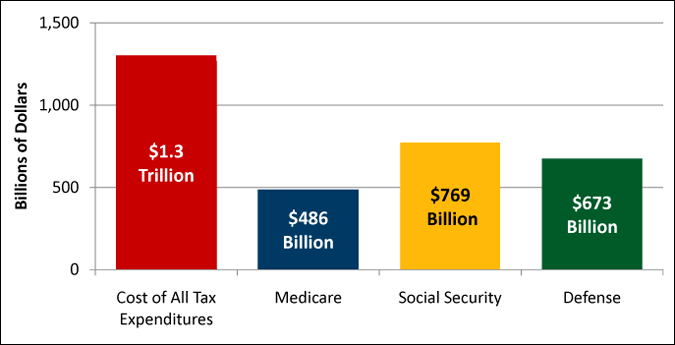You are here
The Debate Over Tax Expenditures
What are tax expenditures and why do reformers want to cut them?
Many tax reform proposals would cut marginal tax rates and offset the resulting lost revenues by reducing or eliminating so-called tax expenditures. That is what policy makers mean when they talk about "lowering rates and broadening the base."
Tax expenditures are costly: they reduce tax revenues by more than $1 trillion each year.
Tax expenditures are provisions in the tax code that allow individual and corporate taxpayers to reduce their tax bill. They include popular "write-offs", such as deductions for mortgage interest and charitable contributions, as well as obscure provisions, such as expensing for multi-period timber growing costs. Some reduce the amount of income that is taxed, such as excluding the value of employer-sponsored health insurance from employee income. Other provisions tax some forms of income at preferential tax rates, such as low rates on capital gains and dividends. Last, some tax expenditures, called credits, reduce the amount of taxes due, such as one for making energy efficient improvements to existing homes. Three tax credits, including the earned income and child tax credits, are refundable — if the credit exceeds the amount of tax owed, the taxpayer receives a check, or refund, for the difference from the Treasury.
Tax expenditures are costly: they reduce tax revenues by more than $1 trillion each year. That is more than any single agency or spending program in the budget, including Social Security, Medicare, and the Department of Defense. If tax expenditures were eliminated or reduced, they would generate revenue that could be used to reduce the deficit and cut income tax rates.
Tax expenditures are large in comparison to the government's major programs

SOURCE: Data from the Congressional Budget Office, Updated Budget Projections: Fiscal Years 2012 to 2022, March 2012; Donald B. Marron, "How Large Are Tax Expenditures? A 2012 Update", Tax Policy Center Tax Facts, April 2012.
NOTE: All figures reflect fiscal year 2012 projections. Medicare spending is net of premiums and payments from the states. Those receipts were $85 billion in 2012.
Tax expenditures are often "spending in disguise" because they are used by Congress to direct resources to specific constituencies and priorities — much like spending programs. Many of those expenditures are essentially subsidies for favored activities. Because politics plays a big role in determining the size and scope of those subsidies, they can distort economic decisions and reduce the productivity of our economy.
The cost of tax expenditures for individuals far exceeds the cost of corporate tax expenditures, by a factor of 6 to 1. Although tax expenditures are used by many Americans, they tend to disproportionately benefit the wealthy. Almost a quarter of the value of all individual income tax expenditures go to the top one percent of earners, but many such as the mortgage interest deduction also benefit the middle class.
For more on taxes, see PGPF's Taxes Primer and Tax Rate Explainer.
